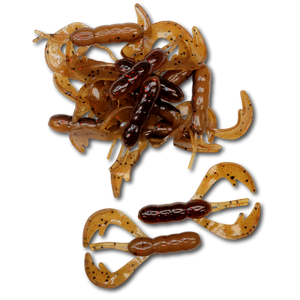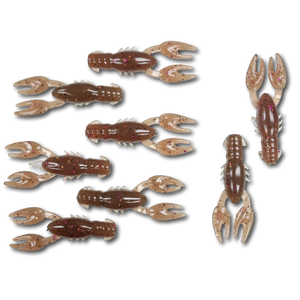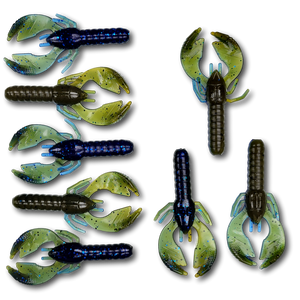Crawfish are a key forage for bass, catfish, and other species, making soft plastic craws an incredibly effective bait. Designed to imitate the natural size, shape, and movement of real crawfish, these baits excel in a variety of presentations and conditions.
Crawfish are bottom dwellers, often hiding in rocks, vegetation, or mud. They’re most active during spring and summer when water temperatures rise, but predatory fish will hunt them year-round. Soft plastic craws replicate this forage with lifelike claws, appendages, and subtle details like ribbed bodies or flake patterns that reflect light to catch a fish’s attention.
Soft plastic craws are among the most versatile baits available, and their effectiveness depends on how they’re rigged and presented.
One of the most popular ways to fish craws is Texas Rigging, which makes the bait weedless and ideal for flipping or pitching into heavy cover like grass mats, laydowns, or brush piles. Pair it with a pegged bullet weight to ensure the craw stays near the bottom where bass naturally hunt for crawfish.
Craws also shine when paired with a jig. Attaching a soft plastic craw as a trailer on a flipping jig, football jig, or swim jig adds bulk and action, making the presentation more appealing. When dragged or hopped along the bottom, the claws flutter naturally, mimicking a fleeing or defensive crawfish.
For a finesse presentation, try a Carolina Rig. This rig keeps the craw near the bottom but allows it to glide naturally with the current, making it perfect for rocky points, ledges, or gravel beds. In clear water or pressured areas, downsizing your craw and fishing it on a Ned Rig can tempt finicky bass.
In shallow water, a weightless rig or a shaky head can also be effective, especially when targeting bass near docks, riprap, or shoreline vegetation.
Craw baits work best when fish are actively feeding on crawfish, which often corresponds with warmer water temperatures and specific habitat types.
- Spring: Crawfish become a primary food source during the spawn. Target shallow cover, such as brush piles or rocks, where bass are protecting nests. A Texas-rigged craw pitched to spawning beds can provoke aggressive strikes.
- Summer: Crawfish remain active, and bass will hunt them near drop-offs, ledges, and weed edges. Dragging a jig-and-craw combo through deeper structure is an excellent summer tactic.
- Fall: Bass move shallow again and actively feed on crawfish along rocky banks and riprap. This is a prime time to use craws on jigs or Carolina rigs.
- Winter: While crawfish activity slows, they’re still on the menu. Use smaller craw baits and fish them slowly along the bottom near deeper structure.
Craws are effective in a variety of habitats, but they excel in areas with hard bottoms—think rocky points, gravel beds, or riprap. These environments are natural homes for crawfish and key ambush points for predatory fish.
Best Colors and Sizes for Craw Baits
Color selection is crucial when fishing craws. Natural tones like green pumpkin, watermelon, and brown work well in clear water, closely matching real crawfish. In murkier water, brighter or more contrasting colors like black and blue, chartreuse, or orange can help fish locate your bait more easily.
Size also matters. Larger craws (4-5 inches) are perfect for targeting bigger bass in summer or fall, while smaller craws (2-3 inches) work best in cold water, pressured environments, or when targeting smaller species like spotted bass.
Why Soft Plastic Craws Are So Effective
Craw baits excel because they trigger both feeding and reaction strikes. Crawfish are high in protein and fat, making them a prime food source for bass. Soft plastics replicate the look and movement of real crawfish so well that fish often strike instinctively, even when they’re not actively feeding.
The subtle claw movement of a soft plastic craw, especially when paired with a jig, mimics the defensive posture of a real crawfish. This triggers territorial aggression in bass and often leads to explosive strikes.
Crawfish and Fishing Strategy: Key Considerations
When fishing craw baits, pay attention to water temperature, clarity, and habitat. Crawfish are less active in colder water, so slow down your presentation and downsize your bait in winter. In warm water, hopping or dragging a craw across the bottom with frequent pauses mimics the movement of real crawfish and entices more bites.
Crawfish activity increases around rocky or hard-bottom areas, so focus your efforts there. Additionally, observe natural crawfish coloration in your fishing area. Many anglers overlook this, but matching your bait color to local crawfish can make a huge difference.
Crawfish Cooking Bonus: Are Crawfish Good to Eat?
If you’re fishing in areas where crawfish can be caught or trapped, you can enjoy this bait as a meal too! Crawfish, also known as crayfish or "mudbugs," are a delicacy in many regions. Try boiling them with Cajun spices, corn, and potatoes for a classic Crawfish Boil, or sauté them in butter and garlic to top pasta or rice.
Soft plastic craws are a must-have for anglers targeting bass and other predatory fish. Their versatility, lifelike action, and ability to provoke aggressive strikes make them one of the most effective baits you can use. Whether you’re flipping a Texas rig, dragging a jig, or finessing a Ned rig, soft plastic craws will deliver results. So stock up on your favorite colors and sizes, hit the water, and get ready for some action-packed fishing!
Qwik Catches!






















